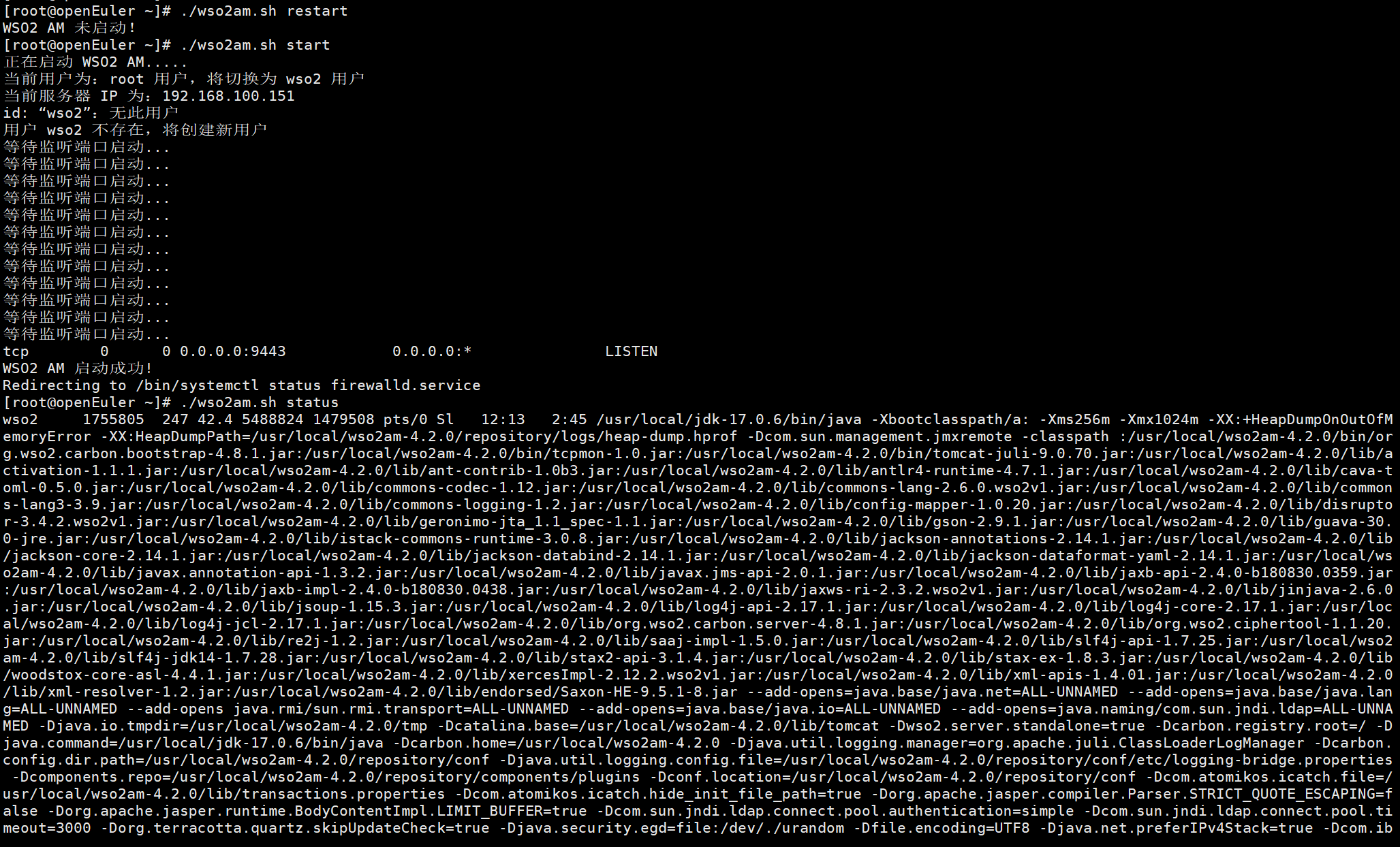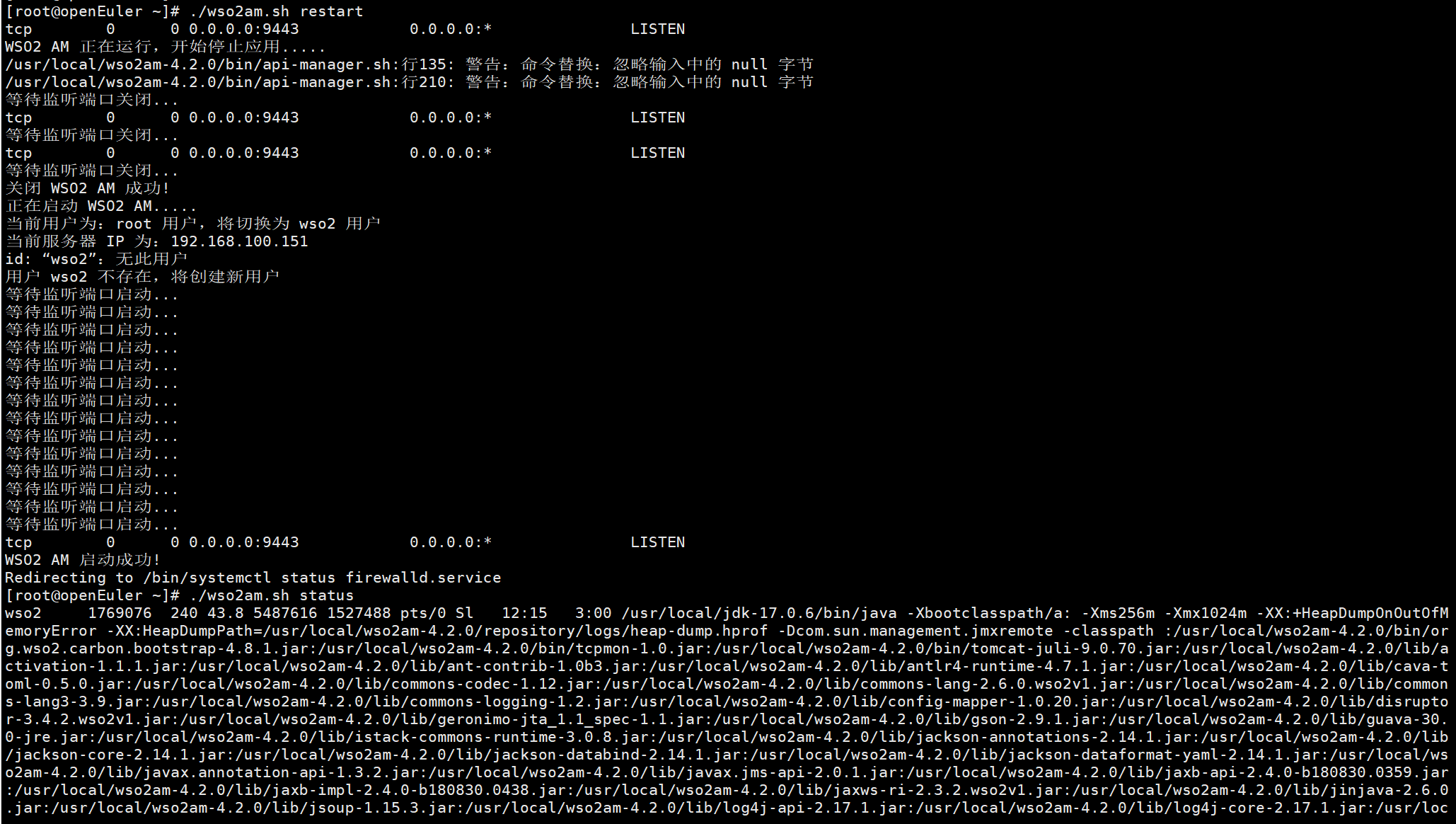touch wso2am.sh && chmod +x wso2am.sh
#!/bin/bash
DATADIR=/usr/local/wso2am-4.2.0
LOG_FILE=/tmp/wso2am.log
# wso2的用户名
WSO2_USER=wso2
# wso2监听端口
WSO2_PORT=9443
check_err()
{
if [ $? -ne 0 ]; then
echo "$1"
exit 1
else
echo "$2"
fi
}
start()
{
#检查是否存在netstat命令,没有则安装
type netstat &> /dev/null
if [ $? -ne 0 ]; then
yum install net-tools -y
fi
netstat -tln | grep ":$WSO2_PORT"
CHECK_RESULT=$?
#取当前用户的变量值,$的前面要加反斜杠
if [ $CHECK_RESULT -eq 0 ];then
echo "WSO2 AM 已启动,请勿重复启动应用!"
exit 1
fi
echo "正在启动 WSO2 AM....."
# id -u为当前用户的uid,root用户uid为0,根据uid是否为0,判断当前用户是否是root
userName=`whoami`
if [ "$userName" != "$WSO2_USER" ]; then
echo "当前用户为:$userName 用户,将切换为 $WSO2_USER 用户"
else
echo "当前用户为:$userName 用户"
fi
ip=`ifconfig ens33 | grep 'inet ' | sed 's/^.*inet //g' | sed 's/netmask.*$//g' | sed 's/ //g'`
echo "当前服务器 IP 为:$ip"
sed -i 's/localhost/'"${ip}"'/g' $DATADIR/repository/conf/deployment.toml
#userdel -r $WSO2_USER
groupadd -g 10000 $WSO2_USER
[ `id -u $WSO2_USER` ] || useradd -u 10001 -g $WSO2_USER -d /home/$WSO2_USER -m $WSO2_USER
check_err "用户 $WSO2_USER 已存在!" "用户 $WSO2_USER 不存在,将创建新用户"
if [ ! -f "$LOG_FILE" ];then
touch $LOG_FILE
chown -R $WSO2_USER:$WSO2_USER $LOG_FILE
chmod 755 $LOG_FILE
fi
chown -R $WSO2_USER:$WSO2_USER $DATADIR/
chmod 755 $LOG_FILE
# 切换为es用户
su $WSO2_USER << EOF
# 不加反斜杠,取的值是切换用户前的
nohup $DATADIR/bin/api-manager.sh >>$LOG_FILE 2>&1 &
#每5s检查一次监听端口是否启动,总共检查60次共10分钟,超时未启动则退出
CHECK_RESULT=1
CHECK_COUNT=60
while [ \$CHECK_RESULT -ne 0 ];do
if [ \$CHECK_COUNT -gt 0 ];then
echo "等待监听端口启动..."
sleep 5
netstat -tln | grep ":$WSO2_PORT"
CHECK_RESULT=\$?
CHECK_COUNT=\$((\$CHECK_COUNT-1))
else
echo "ERROR: 启动$WSO2_PORT端口超时,请检查!"
exit 1
fi
done
echo "WSO2 AM 启动成功!"
EOF
#检查并关闭selinux
CHECK_SELINUX=`getenforce`
if [[ $CHECK_SELINUX != "Disabled" ]];then
#临时关闭selinux
setenforce 0
#配置文件关闭selinux,下次服务器重启后生效
sed -i '/^SELINUX=/s@.*@SELINUX=disabled@' /etc/selinux/config
fi
#检查防火墙是否已启动,如果启动则开放端口
service firewalld status > /dev/null
if [ $? -eq 0 ];then
firewall-cmd --add-port=8672/tcp --permanent
firewall-cmd --add-port=8243/tcp --permanent
firewall-cmd --add-port=8280/tcp --permanent
firewall-cmd --add-port=9099/tcp --permanent
firewall-cmd --add-port=9021/tcp --permanent
firewall-cmd --add-port=9021/tcp --permanent
firewall-cmd --add-port=11111/tcp --permanent
firewall-cmd --add-port=9611/tcp --permanent
firewall-cmd --add-port=9711/tcp --permanent
firewall-cmd --add-port=38163/tcp --permanent
firewall-cmd --add-port=9443/tcp --permanent
firewall-cmd --add-port=8099/tcp --permanent
firewall-cmd --add-port=9999/tcp --permanent
firewall-cmd --add-port=8021/tcp --permanent
firewall-cmd --add-port=5672/tcp --permanent
firewall-cmd --add-port=9763/tcp --permanent
firewall-cmd --reload
fi
}
stop()
{
netstat -tln | grep ":$WSO2_PORT"
check_err "WSO2 AM 未启动!" "WSO2 AM 正在运行,开始停止应用....."
su $WSO2_USER -c "$DATADIR/bin/api-manager.sh stop"
CHECK_RESULT=0
CHECK_COUNT=60
while [ $CHECK_RESULT -eq 0 ];do
if [ $CHECK_COUNT -gt 0 ];then
echo "等待监听端口关闭..."
sleep 5
netstat -tln | grep ":$WSO2_PORT"
CHECK_RESULT=$?
CHECK_COUNT=$(($CHECK_COUNT-1))
else
echo "ERROR: 关闭$WSO2_PORT端口超时,请检查!"
exit 1
fi
done
echo "关闭 WSO2 AM 成功!"
}
status()
{
su $WSO2_USER -c "ps aux | grep $DATADIR | grep -v \"grep\" | grep -v \"su $WSO2_USER\" | grep -v \"$DATADIR/bin/api-manager.sh\""
}
restart()
{
stop
start
}
usage ()
{
echo " "
echo "Please input start to start wso2am."
echo "Please input stop to stop wso2am."
echo "Please input status to get wso2am status."
echo "Please input restart to restart wso2am."
echo " "
}
INPUT_ACTIVE=$1
ACTIVE=${INPUT_ACTIVE:=start}
case ${ACTIVE} in
start)
start
;;
stop)
stop
;;
status)
status
;;
restart)
restart
;;
*)
usage
;;
esac





